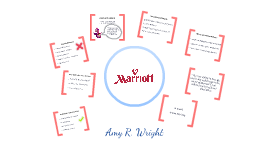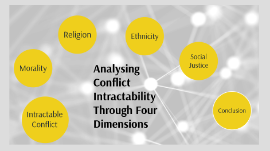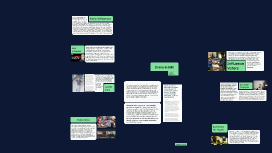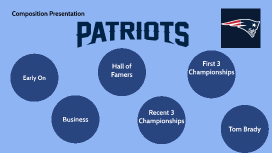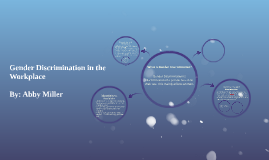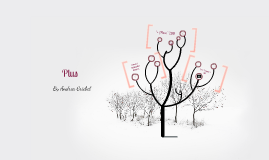comp presentation
Transcript: Analysing Conflict IntractabilityThrough Four Dimensions Introduction Intractable Conflict Exam question: Compare and critically evaluate each of the four themes in terms of their respective advantages and disadvantages when approaching and analysing conflict. Proposed answer: Analysing conflict through these four dimensions makes strong contributions to understanding what makes some conflict intractable but does not necessarily contribute to development of how these conflicts can be resolved. Intractable Conflict (Mitchell, 2014) Intractable Conflict (Mitchell, 2014) “...go on for a very long time and never seem to go away completely,... they appear, at least at first sight, to involve inherent contradictions (logical or empirical or both), or aspirations and goals that are wholly incommensurable (parties confront a dilemma of distributing a good that is indivisible or filling a position that is unsharable), or arise from “worldviews”, ideologies and values systems that simply do not allow for alternative outcomes to those dictated by the beliefs of the party holding them (2014, p.61).” Conflict Goals Conflict “an incompatibility of goals or attainment of a scarce resource to the exclusion of the other individual or group’s attainment of such resource or goal (2014, p.24).” Positive goals may be described as those concerned with bringing out a desired future; Negative goals which are concerned with avoiding an undesired future (1981, p.22). Goals may be material in nature, such as the attainment of scarce resources or the power to distribute them. Goals highlights the purposive quality of conflict processes. 3 Elements of Intractable Conflict 3 Elements of Intractable Conflict 1. Situation that gives rise to conflict. Formation - the situation leading to conflict. Perpetuation - the circumstances that allow conflict to continue. 2. Attitudes and perceptions of the parties involved when parties find themselves in such situations of conflict. Include both affective and perceptual orientations (1981, p.27). Sustain the adversarial relationships that perpetuate conflict. Cannot be addressed in isolation from the situation that gave rise to the conflict and may have a direct impact on a shift in the goals by including new goals of punishing the adversary (1981, p.28). 3. Behavior of clashing parties toward one another. Intended to make the opponent change or desert its goals and take a variety of forms (1981, p.29). Morality Morality View of the moral group, identity, behavior, rights, predictability, prosperity, security (Taylor, Amery) Banality of wrongs/evil in organizations, groups (Amery, Dejours, Milgram) View of right and wrong actions in conflict (Walzer, Amery) Rights, obligations, freedom (Sen, Williams) Modernism, postmodernism and relativism (Geertz, Harvey, Catoriadis) Social psychology (Mikulincer & Shaver, Woodhead) Manipulation of morality (Flint) Alternatives (Ghassem-Fachandi, Ram-Prasad) Advantages Advantages Multidimensional perspective of conflict (before, during and after). Offers foundational understanding of how notions of right and wrong, status, rights and obligations may be viewed from a variety of perspectives. Provides framework for analysing the meaning of morality for a community and for an individual (identity). Provides framework for understanding an evolution of morality debates - from pre-modernity to modernity to postmodernity. Disadvantages Disadvantages Does not necessarily provide a response to the question of how to resolve a moral conflict - does more to explain how morality entrenches a conflict. There is a limited alternative (non-western) view proposed (within the literature explored in the reading list). Religion Religion Impacts of religious identity - belonging, history, ethnicity, nation, community connection to past, present and future (Berliner, Dumont, Geertz, Dumont, Redekop, Werley, Woodhead) Impacts of religious belief in chosenness, transcendence (Akenson, Stern) Motivation to violence, necessity of violence (Palaver, Stern, Jurgensmeyer) Secularism, individualism and modernity (Asad, Greenfeld, Strozier, Walzer) Religion and peacebuilding (Thomas) Advantages Advantages Much like morality, this dimension relates to beliefs of right and wrong, and the relationship between this sense of right and wrong and an individual's relationship with this world. Explains the a modern view of religion as something other than mystical, that can be analysed and understood in its social, historical and anthropological forms. Offers explanations of transcendence and connectedness to the past, present and beyond. Adds economic and political dimensions of religion, demonstrating the depth and breadth of this dimension. Directs attention to the positive contributions of religion to peacebuilding, leading us to question the intractability of the religious dimensions of conflict. Disadvantages Disadvantages Assumptions underpinning what religion is and its impacts are difficult to







